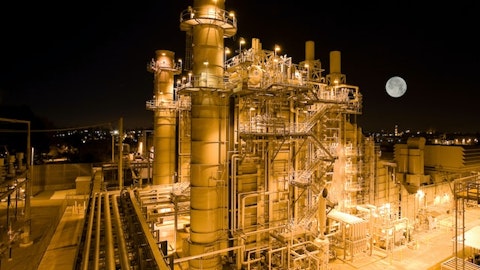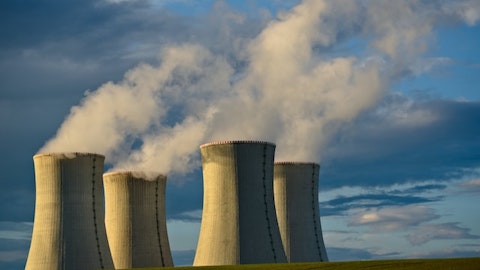Donovan Schafer: Hey guys, thanks for taking the questions. I want to start off with the Ground Game. So it seems like you see simultaneously a lot of opportunity there, while also not a lot of competition. So it sets kind of the economics and opportunities up really attractively while at the same time like what we’ve talked about with kind of more of a lull and larger package deals and some of this Bid/Ask spread stuff on larger probably M&A. So I’m curious, like, so my understanding is maybe what’s going on with the Ground Game is it’s like, people get an AFE [ph] and they’ve got to make a decision quickly. And if it’s an operator or someone with a lot of kind of different irons in the fire and a limited budget they planned for this year.
If there’s an acceleration in activity, then they’re not ready to pull the trigger on all those AFEs or consent to them? And so it kind of becomes almost like a scramble and so maybe there’s more this scramble that’s relevant to like the Ground Game kind of AFE market? And then people dealing with limited budgets, maybe some of that runs-up against ESG stuff where less capital is maybe not as quick to respond to better commodity prices and all? So that’s kind of my understanding. So, just can you confirm, like, is that what you’re seeing and that’s kind of what is happening with the Ground Game or are there other dynamics that are making it so particularly strong right now?
Adam Dirlam: I think directionally you’ve got one of the themes there, right? You’ve got operators that have shareholder return requirements, dividends, buybacks, they want to drill their own wells, whatever it might be and then they’ve got their own set budget and different operators handle their non-op in different ways. Some of those folks are packaging it up and selling it. Some of them are selling them the well proposals as they get them and then you’ve got other operators in order to manage everything. What I kind of alluded to on the second quarter call where they’ve got maybe two obligation wells but it makes more sense to do cube development and they want to drill six. Well, how do you manage your capital there?
You go find a non-op partner, sell down your interest, get a carrier or whatever, a promoter or whatever it might be and you drill additional wells in that regard. And so, I think that’s definitely a theme that we’ve seen. I don’t know that it’s necessarily changed in the short-term, we’ve seen that forever. I’d also add on the competition side of things, there’s definitely competition. It’s just what level of competition are you dealing with at what size of transactions? And that goes back to the comments that we made earlier on the concentration, number of wells, average working interest, all that good stuff. And so you’ve got a handful of different dynamics that are playing. You’ve also got what funds are coming into the year.
Gangbusters generally were not nearly as successful on the Ground Game on front end of the year where everybody’s kind of flush with cash and they’ve got their budget set and they want to deploy it. And then by the end of the year, everybody’s kind of shot their bullets, but the AFEs and the drilling rigs don’t come. And you’ve seen some of that in our Q3 reporting here. So it ebbs and flows, right? And it’s going to be the same thing with commodity pricing. I think it’s almost comical when we see oil rip north at $90 to $95 a barrel. Our competition, we’re getting outbid two to three times, and then as soon as everything pulls back, everybody starts running for the hills. But it’s just a function of the market. Some things can be explained, some things can’t.
Nick O’Grady: Yes. I mean, I think that the third quarter success in the ground, Donovan, is really predicated on the second quarter weakness in oil prices. So the bulk of those transactions were being worked on in the second quarter and likely closed in early third quarter. And you really see the lights of the eyes of people when crude is 60 or in the 60s or low-70s in today’s cost environment. And that’s when we tend to be the most successful. And then, conversely to Adam’s point a month ago with crude in the 90s, we’re shaking our heads at where we see things transact, and that’s just the way it goes.
Operator: Thank you. Our next question is coming from the line of Charles Meade with Johnson Rice. Please proceed with your question.
Charles Meade: Nick, apparently I had a copyright infringement by quoting Trading Places, and the operator cut me off, so sorry for that. Hey, the follow up question I wanted to ask was you – I think Adam mentioned in, you’re talking about the A&D opportunity set. I think you said that some things surprised you, what you’re seeing coming out of Appalachian, especially in light that you guys have been really active in the Permian in the last call 12 or 18 months. But what is surprising about what you’re seeing in Appalachian now is that kind of maybe moving back into focus for you guys?
Nick O’Grady: Yes. I mean, I don’t think it ever went out of focus. I think last year we bought the asset and gas basically ripped from day one, which made it more challenging, especially gas, which is even frankly more volatile than oil, more cyclical buying. We looked at a handful of things last year and just could never get comfortable that buying stuff in a $6 environment was a good idea. But the fact is, it’s been bad for the bulk of this year and suddenly dollars start to become a lot more precious to those counterparties, and it’s shaken loose some activity and there are a lot of exciting things out there. There are also a lot of sort of special situations there were some of the more creative structures that we’ve done in recent times can be very appealing to groups that may not want to sell themselves entirely and things like that.
But I do think we have to be naturally more structured in Appalachian. The land structure of Pennsylvania in particular is very different than, say, New Mexico or North Dakota. So it does, “narrow the field” in terms of how we structure these things. But I think at the end of the day when it comes to non-operated interests, many operators may want to control all that, but then when they’re bleeding money, suddenly those interests become a real thorn in their side and they need a source of capital. So I think we’ve been reviewing, I think everything under the sun in terms of structure there, but I think we’re probably a little bit more optimistic, and I think we take it each day, so don’t take it with a grain of salt, but that we can find ways to grow that position over time.
Adam Dirlam: Yes. I think there was interest last year, but going back to the whole Bid/Ask spread, right? I mean, volatility is going to widen that significantly from a seller’s viewpoint and a buyer’s. And so you’ve kind of had things settle down a little bit, and so there’s maybe a little bit of a backlog. And so now I think we’re having some additional conversations with counterparties where it really didn’t even make sense to have those conversations in the past periods.
Nick O’Grady: Yes. I think we want things that, if gas goes back to $2, $2.50, still work. I mean, it doesn’t have to be pretty, but they’ll work. And a lot of assets that tend to come for sale when gas is $6 look great, but the undeveloped has no value in an environment like this. I think that’s been, honestly, the challenge in the Haynesville. It’s an amazing play, but ultimately you want to be in an environment where you can have some confidence in the outlook, and I think the strip certainly gives you that confidence. But the spot price has not. I mean, obviously it’s been a little bit stronger of late, but I think that should get you there if that makes sense.





